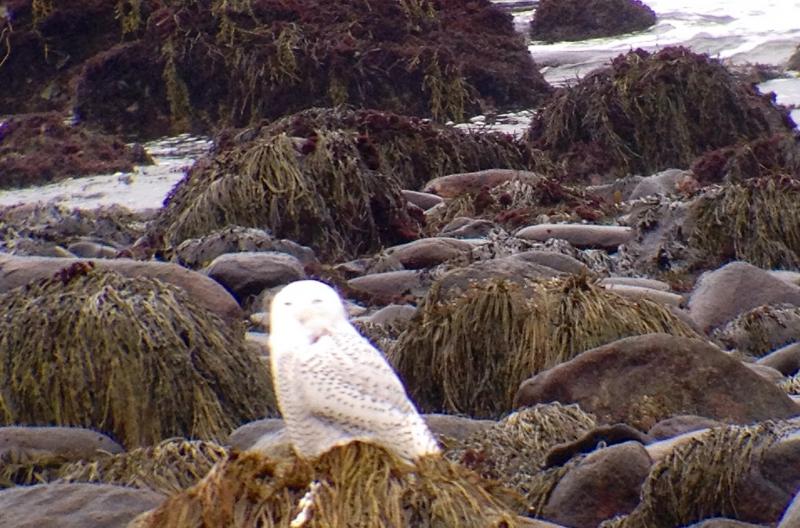Kristen Lindquist: Invasion of the Snowy Owls
We've all admired the National Geographic photos of the serene white owls perched like solitary buddhas on the Arctic tundra. For some birders and photographers, finding the elusive Snowy Owl is an obsession akin to Ahab's quest for the white whale Moby Dick. The rare appearance of this beautiful foreigner in Midcoast Maine can seem like a magical visitation. These are birds that have watched polar bears, after all. They hang out with Harry Potter.
If there's ever been a winter to see a Snowy Owl in the Camden Hills, this is it. By mid-November, the Arctic owls had invaded the Great Lakes region and the Northeast. So many birds were dispersing southward, one was even photographed on a roof in Bermuda! To check out for yourself a live map of this fall's reported Snowy Owl sightings to date on ebird.org, follow this link: http://bit.ly/1eWhlAC.
Here in New England they're being seen in multiples up and down the coast. Over the last weekend of November almost a dozen were found along the tiny strip of New Hampshire that is coastal, seven of those on Hampton Harbor alone. Birders were reporting three or four birds in one scope view there and at Popham Beach, Biddeford Pool, and other open areas. Three individuals were observed on Monhegan Island and at least one in Acadia National Park. A webcam on Mount Agamenticus in southern Maine captured footage of a Snowy perched on the summit observation deck, a mostly unlikely visitor. On Dec. 3, a birder friend on an owl quest found ten in and around Biddeford Pool!
By keeping a safe distance and backing off when a bird appears agitated in any way, you'll ensure that you are not yet another contributing factor to the demise of a bird so far from its natural home.
Of course this abundance of Snowy Owls begs the question: What are they all doing here? And are they massing for a takeover?
The age of many of the owls being seen this year might tell the story. Snowy Owl plumage varies with age and gender. An adult male can be almost pure white, a veritable ghost of a bird flying on silent wings. Females typically show more black barring, while plumage of juvenile birds of either gender is the most heavily barred throughout. Most of the Snowies reported in New England are youngsters. Lots of young birds suddenly appearing in New England indicates one of two general situations: too few rodents or too many.
A food shortage, like a crash in the lemming population, can force hungry birds southward to find new hunting grounds and fend for themselves. Or, what seems more likely, lots of lemmings supported a particularly successful breeding season for the owls, resulting in simply too many young birds hanging around: Get out of here and get your own food, Junior! Rather than an invasion, it's more like an anxious milling around of hungry teenagers, with the New England coast serving as the stocked refrigerator.
And that hunger is something to keep in mind when you see a Snowy Owl. The Arctic tundra is a long way away. These birds had to fly thousands of miles to get here, and as with any migrating bird, are probably under a fair amount of stress. The tendency when we spot a cool bird, especially a big, charismatic one like an owl, is to get as close as you can, especially if you want a photograph. And then the bird flies away. Do that enough and you've got a tired, stressed bird that might not have the energy to hunt well for its next meal. Then you've got a tired, stressed, hungry bird. And soon, given the rigors of winter, a dead bird. Yes, these things are cyclical and inevitably Snowy Owls are found dead during an irruption year, from exhaustion, starvation, collision with a human-made structure, or (in the last Harry Potter movie, at least) attack by an evil wizard. But by keeping a safe distance and backing off when a bird appears agitated in any way, you'll ensure that you are not yet another contributing factor to the demise of a bird so far from its natural home.
Wherever you are this winter, scan the coast, check open fields, look for that round white shape on the beach. Last year a Snowy Owl that hung around the Samoset Resort for several days was spotted on the golf greens, the hotel roof, the breakwater, and the rocky shore. I, for one, hope this winter to see one on the blueberry barrens of Beech Hill in Rockport, a place that's been special to me and my family long before I began working for Coastal Mountains Land Trust, the local nonprofit that has conserved almost 600 acres there. (Click here for a trail map of Coastal Mountains Land Trust's Beech Hill Preserve.) The habitat is perfect—wide-open fields full of rodents and with views of Penobscot Bay—and several have been spotted there over the years. It's just a matter of time.
The owls, those mysterious white emissaries of the remote polar regions, are out there. Keep your eyes open and believe, just a little bit, in magic.
Kristen Lindquist is an amateur naturalist and published poet who works for Coastal Mountains Land Trust in her hometown of Camden.
More Meditations
Spring peepers in autumn: Why are they still talking
Event Date
Address
United States




































